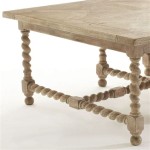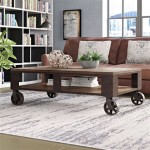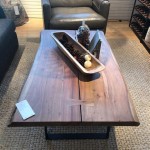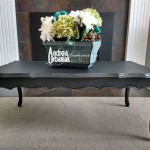Types of Tables for Dining
The dining table stands as a central piece of furniture in many homes, serving not only as a place to eat but also as a gathering point for family, friends, and social interactions. Beyond its fundamental function, the dining table’s style, size, and shape significantly impact the ambiance and aesthetic of a dining space. The vast array of dining table options available can be overwhelming, making it prudent to understand the key characteristics and categories before making a purchase. This article comprehensively explores various types of dining tables, categorized by shape, style, material, and special features, to provide a clear understanding of the available choices.
Dining Table Shapes
The shape of a dining table significantly influences the flow of traffic within a dining area and impacts the number of people it can comfortably accommodate. Different shapes offer different advantages, and selecting the right one depends on the size and layout of the room, as well as the desired seating capacity and overall aesthetic.
Rectangular Dining Tables: Rectangular dining tables are perhaps the most common and versatile option. Their elongated shape makes them suitable for larger dining rooms and can effortlessly accommodate a greater number of diners. They often create a sense of formality and can be easily paired with chairs along their longer sides. Rectangular tables work particularly well in narrow rooms, as they can be positioned lengthwise without obstructing walkways. The linear design complements a variety of decor styles, from traditional to modern. Common sizes range from smaller tables seating four to six people, to larger tables seating eight or more. The length of a rectangular table should be carefully considered in relation to the room’s dimensions to ensure adequate space for movement around the table.
Square Dining Tables: Square dining tables are ideal for smaller spaces or dining areas intended for intimate gatherings. They typically accommodate four people comfortably and foster a sense of equality and conversation amongst diners. The symmetrical shape can be visually appealing and works well in square-shaped rooms. However, square tables can feel cramped if used for larger groups, and extending them may not be practical. Their straightforward design makes them compatible with various design aesthetics, lending a balanced and harmonious feel to the room. When choosing a square table, consider the size of the chairs to ensure a comfortable fit and adequate legroom.
Round Dining Tables: Round dining tables promote a sense of intimacy and encourage conversation among diners. The absence of corners allows for easier movement around the table and creates a more inclusive environment. Round tables are particularly well-suited for smaller dining areas or rooms with unconventional shapes, as they can soften the angularity of the space. While they can efficiently accommodate a smaller group, adding extra chairs around a round table can sometimes feel cramped. Round tables are often a good choice for breakfast nooks or smaller dining spaces within larger kitchens. The diameter of the table should be carefully considered to ensure comfortable seating and adequate space for serving dishes.
Oval Dining Tables: Oval dining tables combine the benefits of both rectangular and round tables. They offer a similar seating capacity to rectangular tables but provide a softer, more organic shape without sharp corners. Oval tables are a good choice for rooms that are not perfectly rectangular, as their curved edges can create a more harmonious flow. They are considered an elegant option and are suitable for both formal and informal dining settings. The curvature encourages conversation and visual appeal. Consider the overall style of the room when selecting an oval table; they often complement traditional or transitional decor styles.
Freeform Dining Tables: Freeform, or organically shaped, dining tables deviate from traditional geometric forms, offering a unique and artistic flair. These tables often feature asymmetrical shapes, mimicking natural forms such as river stones or tree trunks. They are well-suited for modern or eclectic dining spaces seeking a distinctive focal point. Freeform tables can be crafted from a variety of materials, including live-edge wood slabs, resin, or composite materials. Due to their unconventional shapes, it’s important to carefully consider chair placement and the overall flow of the dining area. These tables often require more space and might not be suitable for smaller rooms.
Dining Table Styles
The style of a dining table should complement the overall decor of the dining room or home. Different styles evoke different moods and can significantly contribute to the aesthetic appeal of the space.
Traditional Dining Tables: Traditional dining tables are characterized by their ornate detailing, rich finishes, and classic silhouettes. They often feature elements such as carved legs, intricate moldings, and decorative inlays. Common materials include dark woods like mahogany, walnut, and cherry. Traditional tables often convey a sense of formality and elegance, making them well-suited for formal dining rooms. They frequently pair well with upholstered chairs and traditional-style lighting fixtures. Attention to detail and craftsmanship are hallmarks of traditional dining tables, contributing to their timeless appeal. These tables are ideally suited for homes with a more classic and refined decor.
Modern Dining Tables: Modern dining tables embrace clean lines, minimalist designs, and a focus on functionality. They often feature simple, geometric shapes and a lack of ornamentation. Common materials include metal, glass, and light-colored woods such as maple or birch. Modern tables are often paired with sleek chairs and contemporary lighting fixtures. Their understated aesthetic makes them suitable for a variety of dining spaces, from casual to formal. The emphasis on simplicity and functionality is a key characteristic of modern dining tables. They are often chosen for homes with a minimalist or contemporary decor.
Rustic Dining Tables: Rustic dining tables exude a sense of warmth, character, and natural beauty. They often feature rough-hewn wood, distressed finishes, and visible wood grain. Common materials include reclaimed wood, barn wood, and solid wood with natural imperfections. Rustic tables are often paired with simple, unadorned chairs and earthy-toned accessories. Their relaxed and inviting aesthetic makes them well-suited for casual dining spaces. Rustic tables often bring a sense of the outdoors indoors, creating a cozy and welcoming atmosphere. They are often chosen for homes with a farmhouse, cabin, or country-inspired decor.
Contemporary Dining Tables: Contemporary dining tables represent a blend of modern and traditional styles, incorporating elements of both while maintaining a fresh and updated aesthetic. They often feature clean lines, but may incorporate more decorative elements than strictly modern tables. Common materials include a mix of wood, metal, and glass. Contemporary tables are often versatile enough to complement a variety of dining spaces. They are frequently paired with chairs that combine comfort and style. The emphasis on current trends makes them appealing to those seeking an updated and stylish dining space. Contemporary designs adapt to trends, blending aesthetics and functionality.
Industrial Dining Tables: Industrial dining tables draw inspiration from factories, warehouses, and other industrial spaces. They often feature metal frames, distressed wood tops, and exposed hardware. Common materials include steel, iron, and reclaimed wood. Industrial tables are often paired with metal chairs or stools and industrial-style lighting fixtures. Their rugged and utilitarian aesthetic makes them well-suited for loft apartments, urban spaces, or dining rooms with an edgy vibe. The combination of raw materials and functional design is a key characteristic of industrial dining tables. The style perfectly complements an urban or industrial-themed space.
Dining Table Materials
The material of a dining table significantly influences its durability, appearance, and overall cost. Each material offers unique characteristics, and choosing the right one depends on personal preferences, lifestyle needs, and budget considerations.
Wood Dining Tables: Wood is a classic and versatile material for dining tables, offering a wide range of options in terms of species, finish, and style. Hardwoods like oak, maple, and cherry are known for their durability and resistance to scratches and dents. Softwoods like pine and cedar are more affordable but may be more susceptible to damage. Wood tables can be stained, painted, or left with a natural finish to highlight the wood grain. They are suitable for a variety of dining styles, from traditional to modern. The warmth and natural beauty of wood make it a popular choice for dining tables. Proper cleaning and maintenance are crucial to prolong the beauty of a wooden table.
Glass Dining Tables: Glass dining tables offer a sleek and modern aesthetic. They are often made of tempered glass, which is strong and resistant to shattering. Glass tables can create a sense of spaciousness in a dining room, as they allow light to pass through and do not obstruct the view. They are often paired with metal or wood bases for added support and stability. Glass tables are relatively easy to clean but can be prone to fingerprints and smudges. They are best suited for modern or contemporary dining spaces. Choosing the right glass thickness is important for durability.
Metal Dining Tables: Metal dining tables are durable, sturdy, and often feature a minimalist or industrial aesthetic. Common metals used include steel, iron, and aluminum. Metal tables can be powder-coated or finished with a variety of colors and textures. They are often resistant to scratches, dents, and stains, making them a practical choice for everyday use. Metal tables are often paired with wood or glass tops for added visual interest. They are best suited for modern, industrial, or contemporary dining spaces. The weight of a metal table can be significant; choose one appropriate for the flooring.
Stone Dining Tables: Stone dining tables, such as those made from marble, granite, or slate, offer a luxurious and elegant aesthetic. They are extremely durable and resistant to heat and scratches. Stone tables can be quite heavy and require a sturdy base for support. They are often polished to a high sheen, highlighting the natural beauty of the stone. Stone tables are well-suited for formal dining rooms or spaces seeking a touch of sophistication. The porous nature of some stones requires sealing to prevent staining. These are generally more expensive than other materials.
Laminate Dining Tables: Laminate dining tables offer an affordable and durable alternative to solid wood or stone. Laminate is a synthetic material that is bonded to a substrate, such as particleboard or MDF. Laminate tables can mimic the look of wood, stone, or other materials. They are resistant to scratches, stains, and moisture, making them a practical choice for households with children or pets. Laminate tables are easy to clean and maintain. They are available in a wide range of colors and patterns, making them versatile enough to complement a variety of dining styles. While durable, laminate is more prone to chipping than solid wood.

The Complete Guide To Dining Tables Types And Styles Cabinfield Blog

Guide To Tables

The Complete Guide To Dining Tables Types And Styles Cabinfield Blog

Dining Definitions Our Guide To Popular Types Of Tables Their Features

The Complete Guide To Dining Tables Types And Styles Cabinfield Blog

Common Dining Room Table Shapes Sizes And Base Types Furniture Showcase

Types Of Dining Tabletop Materials And Their Differences

Common Dining Room Table Shapes Sizes And Base Types Furniture Showcase

Options When A Wooden Dining Table

36 Types Of Dining Room Tables Complete 2024 Guide
Related Posts








